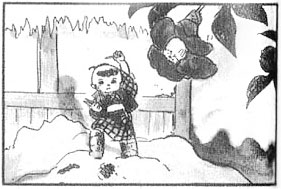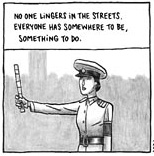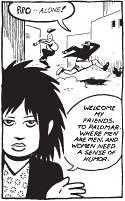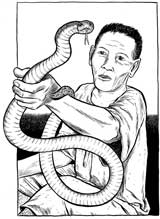Even as a small child, I traveled a lot. My parents enjoyed seeing other places, and had friends in many different countries, so they took me with them on their trips. As a rather freaked-out kid, I was often wary of the upheaval, but I was simultaneously fascinated by the exposure to strange cultures and environments.
Despite all of this early horizon expanding, I had done little traveling outside of well-developed cities, and had a difficult time imagining any rural settings. Even now, I crave trips to cultivated cities. I generally want to experience foreign media, fashion, commerce and culture. I lack some gene that makes me want to “rough it”, in fact it sounds a little daunting. Though I’ve come to enjoy the odd camping trip, I’m very aware that the amount and quality of amenities these American camping trips offer is more than some people experience in their daily lives.
Maybe that’s why I like comics about traveling to (sort of) dangerous places so much, particularly when they’re about places that I will never go to. I’m enthralled by the images and perceptions of these comic travelogues. With no external references to draw upon, the double punch effect of the personal drawings of these comics, alongside first-person narratives (rather than just the text alone of traditional travelogues), gives my imagination that much more to work with. Comics do a better job of creating visual cues to draw from, so that a story set in a completely alien environment can truly come to life, with more depth and dimension than would otherwise be possible. Here (in chronological order of my reading them) are a small selection of the comics that have allowed me to travel to unimagined places.
When I was a teenager and first picked up Love & Rockets, I can tell you honestly that it was the hot punker girls Jaime Hernandez depicted that drew me in. I’d never been to LA, or even thought about visiting the west coast of America, but their lives of hair-dying, arguments, bitchy girlfriends, getting into clubs, and generally trying to get on with their lives really made sense to me. It felt familiar.
But quickly I became as excited by the other stories contained in the book. There, Gilbert Hernandez balanced out Jaime’s guarded city inhabitants, by depicting the fictitious of village of Palomar. Although I was a well-traveled child, as a Londoner born and bred, I’d spent little or no time outside of well-developed cities. I had never even thought to imagine what life in a small village in Mexico might look like, let alone tried to. So imagine my surprise at being pulled so quickly and intensely into Palomar and it’s inhabitants’ lives. With sparse lines and ample use of meaningful looks between the flamboyant characters, Gilbert expertly wove his tales of Palomar. He gave insight into a difficult and rewarding rural life there, and brought an entirely foreign culture to life for me.
 Lone Wolf and Cub: Edo period Japan
Lone Wolf and Cub: Edo period Japan
At around the same time, a Japanese book Lone Wolf and Cub was being chopped up into slim comic-length issues published by Dark Horse. This coincided with my attending my first tiny little comic convention in London (while working for my local store at a stand there). There I found a few issues going cheap, and since my colleagues told me that it was a great title, I thought I’d have a look. Dubiously, I leafed through the story, but quickly became entranced. Edo period Japan isn’t a place any of us can visit anymore, and with my terrible history education, I knew little about how it would look or feel to live in that time. The book gave the places depicted so much atmosphere and depth, and so completely described the culture and politics of the time that I felt attached and involved in a way that would otherwise have been impossible.
At the time, the word “manga” never came up, the book was just another comic in my world, and so the depiction of such a foreign environment seemed like another amazing, outlandish place to take in. But this time it wasn’t in space or in the future, it was simply a foreign historical setting, which eventually made it feel that much more magical. The idea that somewhere far away, this was a people’s regular history (rather than anything fantastic or unusual to them, as it was to me at the time) was astounding to me. It began an attitude that folded Japanese comics into my usual comic reading, without deference for any division between them and my regular pool of comics available to me and this inclusion has enriched my reading enormously.
A series of books that I experienced more recently are these self-published works by a Bay Area comic book creator. Justin Hall pens the oddest grab bag of travelogues I’ve ever read. A brave and adventurous traveler, he documents his (and once in a while, his friend’s) stories of traveling all over the world. Wherever he’s gone, he’s fearlessly sampled the local cuisine, from freshly beheaded snakes and Redbull, drunk in Amazon rain forests, to jellied eels, eaten in London’s East End, (something I never want to try!). Strangely friendly locals and fellow travelers from all over the world mix and take care of each other.
It’s a ton of fun to read about and more fun, (for me at least), than it might be to do the actual traveling. I love the outlandish true stories because they mean that I don’t have to have those crazy adventures in order to experience them. The artwork is detailed and expressive in a very descriptive and human way, imparting a rich sense of the character and personality of the subjects of these first person narratives. These are some wild and unconventional trips, and even the comics themselves aren’t exactly for the faint of heart.
 Pyongyang: A Journey in North Korea
Pyongyang: A Journey in North Korea
This is one of those marvelous examples of how the style and composition of the book speaks volumes about the environment it describes. The simplicity and austerity of the grid and framework of this comic says as much about Guy Delisle’s experience working as an animator in North Korea, as his dialogue does. In fact the words are pretty minimal, simple and direct (very much at odds with his host’s ability to communicate, which is to say that they are less than direct or clear). It all adds to the nonplussed humor that our distracted hero brings to his strange journey. The repetition, the lack of color, even the lack of any extreme tonal variation – all of this points to the fact that the author found himself in an almost suffocating environment, on every level.
I’m making this sound dull, but it’s not. The book is funny and exciting. The tension builds and builds, until it is released in an odd, ebullient little burst of a double-page spread by a fellow illustrator. The spread depicts a moment of inadvertent law breaking when he photographs garbage — which is very illegal. I will never visit North Korea, and so this is a fantastic way to experience the very small, everyday events (or non-events) that comprise a foreigner’s visit to this surreal place.
—
Unintentionally, I’ve picked only black and white comics. Perhaps this is because I prefer them, well executed black and white comics look more interesting to me, more graphic and interesting. Or perhaps it’s because the black and white drawings in these comics echo the travel journals and sketch books of the victorian era, when people would elaborately document their journeys and observations in their private diaries. For whatever reason, this black and white style of simple eloquence is very immediate and satisfying to me, particularly in this context.
These are just 4 out of hundreds of wonderful comics about travel, and I’ve tried not to ruin any surprises by giving overt story descriptions. Still, I hope that your curiosity is piqued enough to give one of them a go, and if there is a comic that describes a place that you’ve fallen in love with, please share it — it’s about time I gave myself another virtual holiday.
After living in 4 different countries, Sonia settled her nomadic self in San Francisco 12 years ago, to design, play, and read comics. Send your travel stories and reading recommendation to sonia@ifanboy.com.




Ah, I remember when the value of my Lone Wolf and Cub #1 went up to ten bucks. I guarded that thing with my life. I would’ve taken a bullet for that comic.
Maus is another great b/w book that takes you somewhere. That Pyongyang book looks intriguing, I’ll have to look for it.
There’s an Italian artist (Gipi? Gepi?) who does brilliant b/w work and the one I read most recently was set in Bosnia (sort of). Would love to know more about him.
Nice article, and enjoyed (I think it was you) your guest spot on the podcast a few weeks ago.
I just got vol 1 of Lone Wolf and Cub. Good stuff.
Nice article! I love Lone Wolf and Cub and actually just finished Pyongyang the other day oddly enough- great reads.
Great idea for a column!! The Pyongyang book is just incredible–I can’t recommend it enough..I gotta check out the other ones…
nice article, Sonia!!
I think Setting gets neglected a lot, which is weird because it’s so visual. Also unusual that books about place are almost always in black and white, as you said. Which reminds me of another graphic novel, Berlin by Jason Lutes, which is excerpted in The Best American Comics 2008. It’s more about the people which collide in that place, but culture really does reflect on setting. Has anyone read either of the Berlin books?
I’d also throw Tintin in there, which is really a book about adventures in foreign lands. Even the moon and fictional easter european nations. Which was always cool because I’d typically pick up Tintin books while on vacation.
I haven’t read Brian Wood’s "Local" yet. but something about all this screams "Local" to me.
The Joe Sacko books have fantastic settings Paul!
I’m more interested in places that sometimes look real and sometimes look like fiction.
I have a love of this places since I can suspend my belief enough to believe that there might be some place like that somewhere in the world.
A Series of Unfortunate Events – that small remote and weird places fascinate me. I want to visit those places but in the same time don’t really want to know that such places exist.
It’s like the street behind The Leaky Cauldron – I don’t need magic (it’s from Harry Potter) but it would be nice to have a street that you enter through a pub and you can stay there and go eat ice cream there in some shop in this hidden street.
The only semi real place I want to visit is the one in Ghost World but it’s because of the people.
There are real places that seem to me to lean more towards fiction like in the book This Boy’s Life – Concrete and the other places.